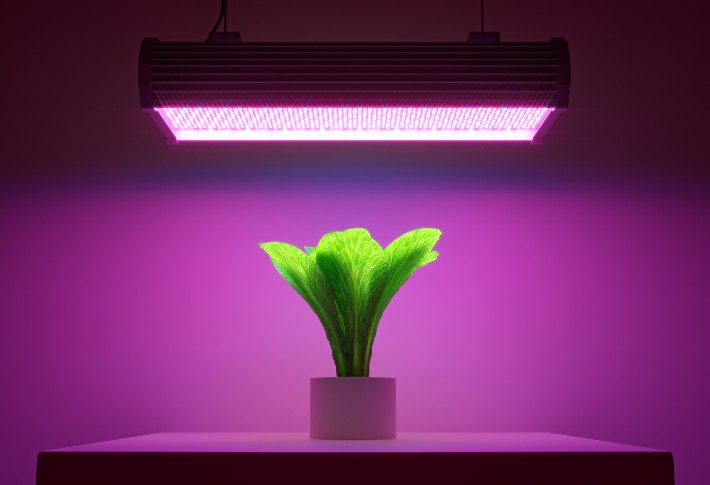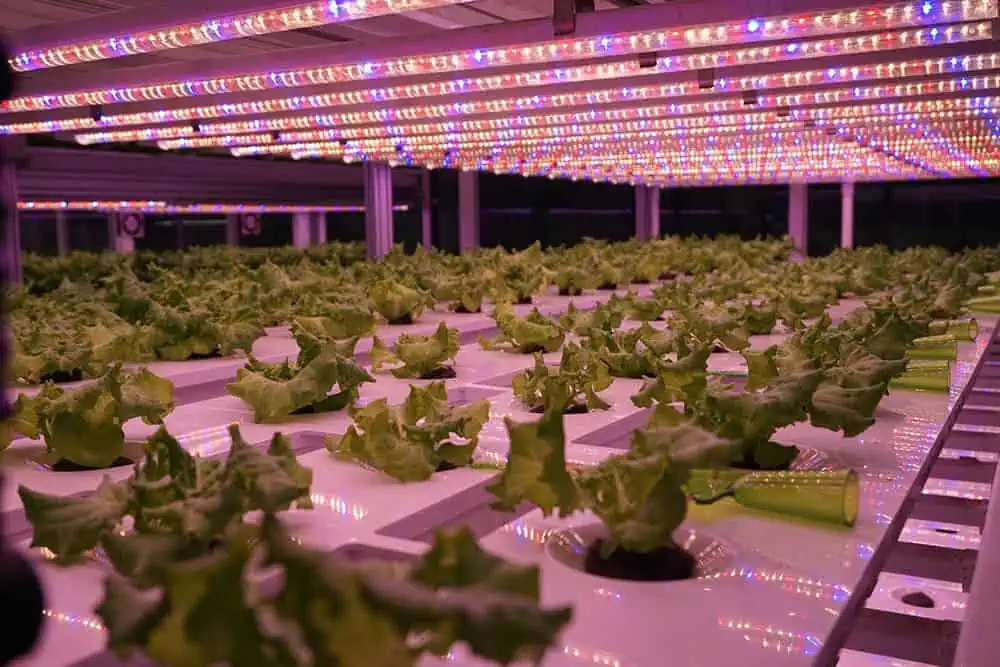LED grow lights greatly promote the growth of plants. LED grow lights provide plants with the effect of simulating indoor sunlight. These lights emit a specific spectrum of light (particularly red and blue) that affects plant growth. Proper use of plant lights can effectively promote plant growth, but improper use can also burn plants.
Below you will learn the reasons why LED grow lights burn your plants. Below I will introduce to you the precautions or measures to be taken to prevent LED plant lights from burning plants:

Ensure proper ventilation and cooling systems
When purchasing LED grow lights, remember that they come with proper heat sinks installed. This will keep the LED running cool and prevent overheating. In addition, the grow room must be well ventilated. There should be adequate airflow system to keep the temperature of the room normal. So if the light fixture emits more heat, it won't be confined to the room. Due to good ventilation, the heat will escape and prevent the plants from burning.
Use high-quality grow lights and fixtures
Buying cheap LED grow lights increases the risk of burning your plants because they use inferior LED chips and other compostable materials. That’s why you should always choose a reputed brand that has expertise in manufacturing LED grow lights. The lamps of these brands feature neatly arranged LEDs and high-quality materials. Additionally, high-quality bulbs use heat sinks that won’t overheat the fixture, damaging your plants. But where can you find top-notch LED grow lights? No need to worry, Hishine Group Limited offer a series of grow lights, such as Hishine PG03 grow light.
Consider the PPFD value
PPFD gives better accuracy than Lux regarding the light intensity requirements of plants. PPFD stands for Photosynthetic Photon Flux Density, which measures the amount of light reaching the crop canopy in the PAR zone. Depending on the growth stage of the plant, the PPFD required by the plant ranges from 100 to 1,000 μmol/m2/s. Therefore, if you don’t want your plants to get burned due to excessive light intensity, follow this chart during cultivation:
| Plant growth stage | Recommended PPFD |
| Seedling stage | 100 – 300 micromol/m2/sec |
| Vegetative period | 400 – 600 micromol/m2/sec |
| Flowering period | 800 – 1,000 micromol/m2/sec |
Maintain appropriate distance between lights and plants
Different stages have different lighting requirements and lighting distances. This is why in industrial-scale production separate rooms are used for the germination and growth stages of plants. If you are a gardening or indoor growing enthusiast, go for a portable dimmable LED grow light. With this light, you can increase or decrease the lighting distance for different growth stages of your plants. Below, I’ve added recommended distances between LED grow lights and plants for different stages of growing:
| Planting stage | The distance between LED grow lights and plants |
| Seedling stage | 24-36 inches from top of soil |
| Vegetative period | 12-24 inches |
| Flowering and fruiting period | 16-36 inches from plant canopy |
NOTE: Recommended spacing between plants and LED grow lights may vary based on the size and light intensity of the fixture.
Consider factory specific requirements
Summer plants require more sunlight than winter plants. Likewise, light pony needles vary for flowers, vegetables, and herbs. So, when you use LED grow lights for indoor gardening, you cannot turn them on 24 hours a day. These fixtures provide them with artificial lighting, replacing daylight that affects daylight. So, you also need to open them up so they feel the night and stop photosynthesising. Additionally, leaving them on all day will also increase room temperature, increasing the chance of plants burning. Therefore, you should maintain the light duration of your LED grow light as per the requirements of your plants. Here, I've added a chart to help you understand how long different plant types need to keep their LED grow lights on:
| Plant type | Required lighting time | Watts | For example |
| Vegetable | 16 18 hours | 25-50 watts/square foot | tomatoes, peppers and cucumbers |
| Spices | 14-16 hours (full sun plants) | 30-40 watts/square foot | basil and rosemary |
| 10-12 hours (low light plants) | 20-30 watts/square foot | parsley and mint | |
| Flower | 8-16 hours (depending on variety) | 15-50 W/ft² (depending on variety) | African violets (part shade), orchids (bright light) |
| Houseplant | 8-12 hours (low light) | 15-20 watts/square foot | Snake plants, ZZ plants, pothos, philodendron |
| 12-14 hours (medium light) | 20-30 watts/square foot | Spider plant, peace lily, dracaena, eucalyptus | |
| 14-16 hours (bright light) | 30-40 watts/square foot | String of pearls, succulents, cacti, citrus trees |
Monitor body temperature regularly
Maintaining the proper temperature in your gardening or grow room is crucial to preventing plant burn. LED lights have specific operating temperatures. When the room temperature is too high, it destroys the performance of the LED and increases the chance of plant burning. Therefore, it is important to monitor room temperature regularly. For this, you can use a thermometer and hygrometer. Target a temperature range of 65-80°F (18-27°C) and a humidity of around 40-60%, although this may vary with different plan types.
To maintain this temperature, you can use a cooling system that takes into account the climate in your area. For example, maintain an adequate ventilation system in the garden room. You can use an exhaust fan to move hot air out of a room and allow cooler air into the space. Likewise, you can use an air conditioner to strictly maintain the temperature. However, using AC can be expensive. In this case, you can use evaporative cooling as a cost-effective option. The disadvantage is that evaporative coolers can only be used in dry climates.
Like wise, if you are growing indoors in a cooler area where temperatures drop below freezing, you must use a heater. Using a heater in a room can also be very dangerous. If the temperature is too high, it will directly burn the plants. In addition, it will also heat up the LED grow light, affecting its normal operation and causing fire.
Wiring using a junction box
Overloaded or incorrectly wired wires in LED grow lights can cause your plants to burn. To prevent this, you should use a junction box for wiring. This will protect the wire hubs in the circuit. So when installing LED grow lights, tell your electrician to use a junction box.

Take precautions to stop fire outbreaks
Even if all of the above measures are taken, there is still a chance that LED grow lights may accidentally burn your plants. That’s why it’s best to take the necessary steps to take action by changing the fire exit in your garden room. Here's what you should have:
Install smoke alarms: Fires can break out at any time, and it's not always possible to manually monitor your garden 24/7. This is why you should install a smoke alarm. If a grow space catches fire, an alarm will sound and you can take action to save your plants from burning.
Fire Extinguisher: You should also install a fire extinguisher to stop the spread of fire. The extinguishing agent in a fire extinguisher quickly diffuses carbon dioxide, stopping the fire. This will help you control small fires that break out immediately and prevent your plants from burning further.
Purchase a sprinkler system: If you have an industrial-scale growing project, a sprinkler system can help you put out fires. With this, you can quickly get a well-set up water unit to spray water on the fire suppression area.
Use fire-rated doors: For a high level of protection, use fire-rated doors. These doors are made of glass, steel, metal and wood. Using these doors in your grow room will prevent the spread of fire.
Minor burns vs. Nutrient burning
Both light burn and nutrient burn can negatively affect plant growth. Photoburn occurs due to too much sunlight, and nutrient burn is caused by high levels of nutrients in the soil. Due to the large amount of nutrients present in the soil, the plants do not get enough water. Nutrient particles in the soil block water and prevent it from entering the transport cycle. This is why nutrient burning occurs.
The leaves of the plant will change color under both vegetative and light burn conditions. These are the only visible symptoms in the initial stages, making it tricky to differentiate between photoburns and trophic burns. However, you should consider the direction of leaf color change to determine whether it's a vegetative burn or a mild burn.
Mild burns can occur due to excessive sunlight, affecting the upper leaves first. You will notice that the leaf tips on the upper parts of the plant are starting to turn yellow. And gradually flows downward. Instead, when nutrients burn with the soil, the lower leaves of plants in the forest are affected and spread upward. Below I've added a comparison chart to help you find the differences:
| Standard | Light burn | Nutrient burning |
| Reason | Too much light | Excess nutrients present in the soil |
| Symptom | Leaves start to turn yellow from the tips | Leaves turn yellow or brown in color starting from the tips |
| Plant color change direction | from top to bottom
| from bottom to top
|
Author 2025-06-12
Hishine Group Limited Will Meet Customers In Mexico City.Hishine is thrilled to announce its participation in Expo Eléctrica International 2025, Latin America’s premier trade fair for power and lighti...
Author 2025-05-12
Our recent business trip to Saudi Arabia proved to be a pivotal step in strengthening partnerships and exploring opportunities in the Kingdom’s rapidly growing energy and lighting markets. Below are t...